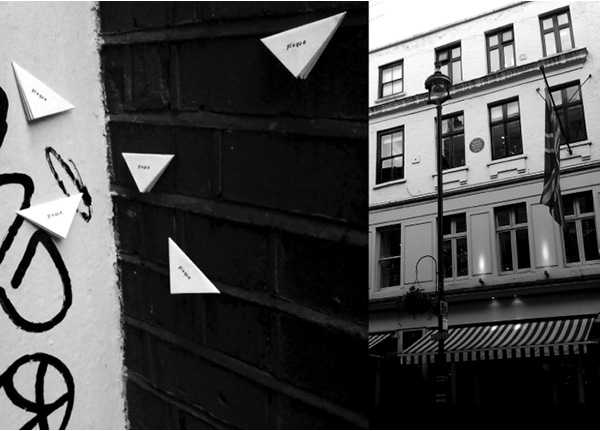
PLAQUE
first performed on February 13, 2015
Dean Street, Soho, London, UK
performed once in 2015
JENNIE COLE
London, UK
267706113j267706113e267706113n267706113n267706113i267706113e267706113.267706113c267706113o267706113l267706113e267706113@267706113h267706113o267706113t267706113m267706113a267706113i267706113l267706113.267706113c267706113o267706113m
jenniecole.org
PLAQUE
JENNIE COLE
“Plaque” was a performative piece of site-specific writing and an edition of 30 small book-objects presented in the form of folded paper. On February 13, 2015, these objects were placed in Soho, London as a citational act engaging text, image, physical location, and date.
The citations contained within the folds of these objects were selected to emphasize their placement relative to the plaque on the facade of 28 Dean Street, commemorating Karl Marx’s residence there. This piece also possesses temporal specificity, being enacted on the 152nd anniversary of a comment made by Marx regarding the area in a letter written to Friedrich Engels on February 13, 1863, which reads:
I know from my own experience how the region
round Soho Square still sends a shiver down my spine
if I happen to be anywhere near there.
The final fold of each paper book-object contains this citation.
The folds of the object present a sequence of excerpts and references whose accumulations establish the significance of the piece in connection with its site. Soho is now an affluent area with a longstanding reputation as a centre for art, advertising, and media activity, also notorious for its high rents. The rooms once occupied by Marx now sit above the restaurant Quo Vadis at 26-29 Dean Street. This contrasts sharply with the area’s reputation when the Marx family resided there, which a Prussian spy surveilling Marx in 1852 described as “one of the worst, therefore one of the cheapest, quarters of London.” The family’s time on Dean street was marked by hardship, including illness and the deaths of three of the Marx children in the home.
“Plaque” plays on notions of the tangential, spurious and transitory in relation to acts of commemoration and monumentalization. It provokes comparison between the ephemeral ‘plaques’ of folded paper and the weight and permanence of the official plaque, between the activity of the heritage industries and the dispersed and repetitious placement of these transient objects in the surrounding streets and alleys.
Through the references folded within its citational structure, the twofold approach to
site-specificity in “Plaque” enables the work to engage conceptions of heritage, reputation and legacy, as an exploration and challenge towards acts of commemoration and the significance of monuments.